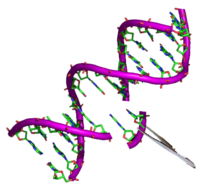
Photo from wikipedia
To better assess the risk of microplastics (MPs) as a vector for contaminants, it is essential to understand the relative importance of MPs compared to other pathways for chemical transfer… Click to show full abstract
To better assess the risk of microplastics (MPs) as a vector for contaminants, it is essential to understand the relative importance of MPs compared to other pathways for chemical transfer as well as the consequences of co-exposure. In this study, we exposed Japanese medaka (Oryzias latipes) to anthracene (ANT, 0.1 mg/L) in the presence or absence of pristine polyethylene MPs (PE-MPs, 106 beads/L), to quantify the vector effect of PE-MPs on ANT accumulation. Under the ANT-MPs co-exposure conditions, PE-MPs rapidly accumulated in the gastrointestinal tract of the medaka during a 14-day uptake phase, with an average bioconcentration factor of 171.4 L/kg. The PE-MPs could absorb and accumulate approximately 70 % of the ANT from the water sample. The PE-MPs changed the pharmacokinetic profile of ANT in medaka by decreasing both the uptake and depuration rate constants. The one compartment with first-order elimination model estimated that the amounts of ANT in the water phase and absorbed by PE-MPs (i.e., a vector effect) contributed about 67 % and 33 % of the ANT accumulation in medaka, respectively. At the end of the uptake (exposure) phase, however, the presence of PE-MPs did not significantly alter the final ANT concentrations in the fish body or alter the behavioral impacts of ANT. Thus, PE-MPs ingestion may act as a vector to concentrate and transfer ANT to medaka, but the presence of these particles may have limited adverse effects on fish under co-exposure systems of the type used in this study.
Journal Title: Aquatic toxicology
Year Published: 2020
Link to full text (if available)
Share on Social Media: Sign Up to like & get
recommendations!